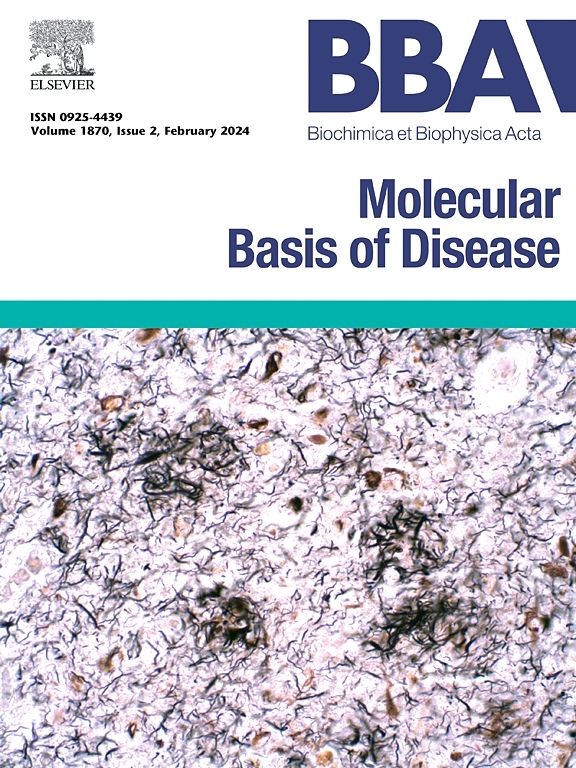Exploring the role of the CD74+ cardiac macrophage subset in trastuzumab cardiotoxicity and its mechanisms
IF 4.2
2区 生物学
Q2 BIOCHEMISTRY & MOLECULAR BIOLOGY
Biochimica et biophysica acta. Molecular basis of disease
Pub Date : 2025-04-30
DOI:10.1016/j.bbadis.2025.167875
引用次数: 0
Abstract
Trastuzumab (TRZ) is the standard treatment for human epidermal growth factor receptor 2 (HER-2) positive breast cancer, but its cardiotoxicity significantly impacts the prognosis and quality of survival of patients, and the underlying mechanism of TRZ-related cardiotoxicity remains incompletely understood. Macrophage subsets better reflect macrophage heterogeneity than the traditional macrophage M1/M2 type polarization classification. CD74, a receptor with strong binding affinity for macrophage migration inhibitory factor, plays an important role in macrophage activation. After successfully constructing a mouse TRZ cardiotoxicity model, flow cytometry indicated that CD74+ cardiac macrophages (CMφs) were significantly elevated in the TRZ group. Single-cell data were utilized to identify CD74+ CMφs, GO and KEGG analyses of the DEGs were conducted to further validate the CD74/STAT1 signaling pathway. Analyses using RT-PCR, immunofluorescence, and western blot revealed a marked increase in the expression of genes and proteins linked to this pathway in TRZ-treated group. Additionally, levels of inflammation-related factors and the expression of apoptotic proteins was elevated following TRZ treatment. CD74-knockdown RAW 264.7 macrophages cell line were constructed via Lentiviruses carrying CD74 (hU6-MCS-CBh-gcGFP-IRES-puromycin) transfection and co-cultured with HL-1 cardiomyocytes to establish an in vitro TRZ cardiotoxicity model. Western blot analysis of CD74/STAT1 signaling pathway protein levels demonstrated that CD74 knockdown rescued TRZ-induced cellular damage. These findings suggest that TRZ may promote inflammation and apoptosis in cardiomyocytes, leading to cardiotoxicity through the CD74+ CMφ subset, which regulates the CD74/STAT1 signaling pathway. CD74+ CMφs are anticipated to be a novel intervention target and therapeutic strategy for addressing TRZ-induced cardiotoxicity.

探讨CD74+心脏巨噬细胞亚群在曲妥珠单抗心脏毒性中的作用及其机制
曲妥珠单抗(TRZ)是人表皮生长因子受体2 (HER-2)阳性乳腺癌的标准治疗方案,但其心脏毒性显著影响患者预后和生存质量,TRZ相关心脏毒性的潜在机制尚不完全清楚。巨噬细胞亚群比传统的巨噬细胞M1/M2型极化分类更能反映巨噬细胞的异质性。CD74是一种与巨噬细胞迁移抑制因子结合亲和力强的受体,在巨噬细胞活化中起重要作用。成功构建小鼠TRZ心脏毒性模型后,流式细胞术显示,TRZ组CD74+心肌巨噬细胞(CMφs)显著升高。利用单细胞数据鉴定CD74+ CMφs,对deg进行GO和KEGG分析,进一步验证CD74/STAT1信号通路。RT-PCR、免疫荧光和western blot分析显示,trz处理组与该通路相关的基因和蛋白表达显著增加。此外,TRZ治疗后炎症相关因子水平和凋亡蛋白表达水平升高。通过携带CD74 (hu6 - mcs - cbh - gcgfp - ires - purromycin)的Lentiviruses转染,构建CD74敲低的RAW 264.7巨噬细胞细胞系,并与HL-1心肌细胞共培养,建立体外TRZ心脏毒性模型。CD74/STAT1信号通路蛋白水平的Western blot分析表明,CD74敲低可挽救trz诱导的细胞损伤。这些发现表明,TRZ可能通过调节CD74/STAT1信号通路的CD74+ CMφ亚群,促进心肌细胞的炎症和凋亡,从而导致心脏毒性。CD74+ CMφs有望成为解决trz诱导的心脏毒性的新的干预靶点和治疗策略。
本文章由计算机程序翻译,如有差异,请以英文原文为准。
求助全文
约1分钟内获得全文
求助全文
来源期刊
CiteScore
12.30
自引率
0.00%
发文量
218
审稿时长
32 days
期刊介绍:
BBA Molecular Basis of Disease addresses the biochemistry and molecular genetics of disease processes and models of human disease. This journal covers aspects of aging, cancer, metabolic-, neurological-, and immunological-based disease. Manuscripts focused on using animal models to elucidate biochemical and mechanistic insight in each of these conditions, are particularly encouraged. Manuscripts should emphasize the underlying mechanisms of disease pathways and provide novel contributions to the understanding and/or treatment of these disorders. Highly descriptive and method development submissions may be declined without full review. The submission of uninvited reviews to BBA - Molecular Basis of Disease is strongly discouraged, and any such uninvited review should be accompanied by a coverletter outlining the compelling reasons why the review should be considered.

 求助内容:
求助内容: 应助结果提醒方式:
应助结果提醒方式:


